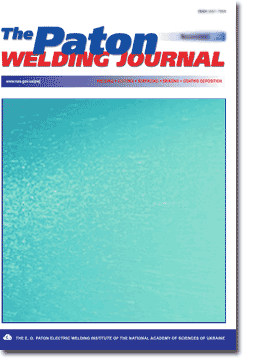

| SCIENTIFIC AND TECHNICAL | |
| Pokhodnya I.K. and Portnov O.M. Mathematical modelling of absorption of gases by electrode metal drop. | 2 |
| The mathematical model is composed from a combined solution of the system of equations of gas mass transfer in metal, in the near-surface Knudsen layer, adjacent to metal, and in the atmosphere of arc discharge. Modelling of metal evaporation and gas absorption is based on a combined solution of Boltzmann kinetic equation for Knudsen layer and system of equations of continuum for the ambient atmosphere using numerical methods. The effect of gas content in atmosphere and drop temperature on the kinetics of the absorption process has been investigated. | |
| Lobanov L.M., Mikhoduj L.I., Poznyakov V.D., Mikhoduj O.L., Kasatkin S.B., Sergienko A.A. and Strizhak P.A. Method of evaluation of effect of residual stresses on formation of longitudinal cold cracks in alloy steel welded joints. | 6 |
| Technological sample amd procedure of investigations have been developed that makes it possible to evaluate the effect of residual stresses on the resistance of welded joints with multilayer welding to the formation of longitudinal cold cracks. The relationship between the level of residual stresses and resistance to the formation of longitudinal cold cracks of 14KhGN2MDAFB steel welded joints, made using wire Sv-10KhGN2SMFTYu in 75 % Ar + 25 % CO2 mixture of gases, was established. | |
| Yushchenko K.A., Starushchenko T.M., Nakonechny A.A., Chervyakova L.V., Shepil T.E., Kachanov V.A. and Danilov Yu.B. Investigation of corrosion fracture of welded joints in Ni-Cr-Mo alloys in titania production environment. | 11 |
| Susceptibility of ThyssenKrupp VDM nickel-chromium-molybdenum alloys to corrosion cracking was evaluated. Samples with annular welds made by the argon-arc method using filler wire of the AWS A.5.14ERNiCrMo-13 grade were tested in the titania production environment. It is shown that reliable data can be generated from testing experimental models or stressed welded samples with an annular weld simulating residual stresses in a structure. | |
| Petushkov V.G. Peculiarities of explosion treatment of the circumferential weld on pipe filled with liquid. | 14 |
| The problem is considered for a case of filling a pipe with water in an assumption of axial symmetry of geometric and force parameters of loading, using a stiff-plastic model of a medium and a known method of reflected shock adiabats. It is shown that the presence of liquid in the pipe leads to a substantial decrease in its explosion reduction, thus preventing the use of a traditional method of treatment with external explosive charges placed at a distance from the weld to relieve residual stresses. The effect of liquid is such that it becomes possible to load the pipe directly on the weld, the liquid acting as a kind of support. | |
| Ryabtsev I.I., Kuskov Yu.M., Grabin V.F., Gordan G.N., Solomijchuk T.G. and Polotaj V.V. Tribological properties of the Fe-Cr-Si-Mn-P system deposited metal. | 16 |
| Studies of assimilation of phosphorus in open-arc and submerged-arc (with fluxes AN-26 and AN-348) surfacing using flux-cored wires containing up to 2.5 % P, as well as tribological properties (sliding friction coefficient and wear resistance) and structure of deposited metal of the Fe-Cr-Si-Mn-P alloying system, were conducted. Almost all phosphorus was found to be assimilated by the deposited metal in surfacing by the flux-cored wire open-arc and submerged-arc (with fluxes AN-26 and AN-348) methods. It is shown that samples of the deposited metal alloyed with 0.9-1.2 % P have a minimum sliding friction coefficient, and a minimum wear of the sample and mating body is provided at a phosphorus content of 2.0 %. | |
| Tsybulkin G.A. On the influence of the speed of variation of electrode extension and arc length on arc sensor signal. | 21 |
| Physical principles are considered, which underlie the action of arc sensors. Analytical dependencies are given of welding current on the current distance between the torch edge and weld pool surface, as well as the speed of variation of this distance. | |
| INDUSTRIAL | |
| Golovko V.V. Application of agglomerated fluxes for welding of low-alloy steels (Review). | 25 |
| It is shown that agglomerated fluxes are characterised by higher metallurgical activity, compared with the fused ones. Their application fields in fabrication of facilities from structural low-alloy steels are given. It is noted that development of these type of welding consumables holds high promise. | |
| Kireev L.S., Shurupov V.V., Peshkov V.V. and Batishchev A.A. Diffusion bonding of titanium structures (Review). | 29 |
| Analysis of modern concepts of the mechanism of formation of the welded joint, produced by diffusion bonding, was used demonstrate that this welding process is a promising technology to produce titanium structures with developed surfaces in terms of geometry, which permits making high-quality precision joints. | |
| Zhuk G.V., Trigub N.P. and Zamkov V.N. Welding of titanium ingots using dispersed melt. | 34 |
| It was established that it is possible to weld titanium alloys using a flow of dispersed melt. In this case the welded joint possesses mechanical properties at the level of appropriate properties of joints made by fusion welding. It is shown that this method of joining can be applied for enlargement of titanium ingots. After deformation of welded ingots the structure and properties of weld metal do not differ from similar characteristics of the rolled ingot. | |
| Lebedev V.A. Improvement of the guide channel and roller feed assembly of semi-automatic machines for welding aluminium and its alloys. | 37 |
| A new approach is proposed to design of elements of the system of electrode wire feed, which is practically completely based on selection of materials, which perform in the most effective manner in the specific assemblies of this system, or on a combination of these materials with the design solutions for the mechanism of transfer of motion from the rollers to the wire. The above technical solutions and the above approach on the whole can be widely applied both in the currently used equipment for mechanized welding of aluminium and in the semi-automatic machines being developed. | |
| BRIEF INFORMATION | |
| Maksimov S.Yu., Prilipko E.A., Ryzhov R.N. and Kozhukhar V.A. Effect of external electromagnetic action on hydrogen content in weld metal in wet underwater welding. | 41 |
| It was established that application of electromagnetic action is an effective method of degassing welds. The presence of extremum in experimental curves will make it possible to optimize the parameters of controlling magnetic field. | |
| Pulsed stabilization of alternating current welding arcs. | 44 |
| NEWS | |
| International Conference "Laser Technologies in Welding and Materials Processing". | 46 |
(You are viewing the simplified file contents)
Sorry, the PDF of this issue is not yet available
The cost of subscription/purchase order journals or individual articles
| Journal/Currency | Annual Set | 1 issue printed |
1 issue |
one article |
| TPWJ/USD | 384 $ | 32 $ | 26 $ | 13 $ |
| TPWJ/EUR | 348 € | 29 € | 24 € | 12 € |
| TPWJ/UAH | 7200 UAH | 600 UAH | 600 UAH | 280 UAH |
| AS/UAH | 1800 UAH | 300 UAH | 300 UAH | 150 UAH |
| AS/USD | 192 $ | 32 $ | 26 $ | 13 $ |
| AS/EUR | 180 € | 30 € | 25 € | 12 € |
| SEM/UAH | 1200 UAH | 300 UAH | 300 UAH | 150 UAH |
| SEM/USD | 128 $ | 32 $ | 26 $ | 13 $ |
| SEM/EUR | 120 € | 30 € | 25 € | 12 € |
| TDNK/UAH | 1200 UAH | 300 UAH | 300 UAH | 150 UAH |
| TDNK/USD | 128 $ | 32 $ | 26 $ | 13 $ |
| TDNK/EUR | 120 € | 30 € | 25 € | 15 € |
AS = «Automatic Welding» - 6 issues per year;
TPWJ = «PATON WELDING JOURNAL» - 12 issues per year;
SEM = «Electrometallurgy Today» - 4 issues per year;
TDNK = «Technical Diagnostics and Non-Destructive Testing» - 4 issues per year.


